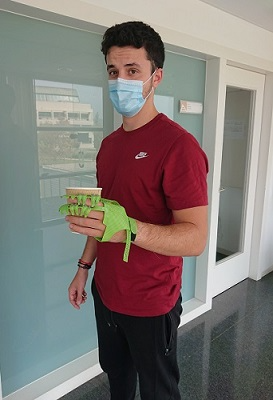Oct 8 2020
At the University of Alicante ArtefactosLAB, the Engineering Design and Technological Development Group (DIDET) has once again taken a step ahead concerning social innovation with the design of a new handheld robotic exoskeleton.

Image Credit: RUVID.
Dubbed [flick], the robotic exoskeleton enhances the lives of people with restricted or no ability to move because of physiological and/or neurological disorders.
This is a user-adaptable, cost-effective, and portable 3D printed exoskeleton designed with the aim of helping those people with low or no muscle tone caused by chronic pathologies, neurological disorders, or any kind of accident that has left their hands immobile, as described by the University of Alicante (UA) researcher and engineer Javier Esclapés.
The device, which is inspired by artificial intelligence and already patented, has been made of a breathable, liquid-resistant, and flexible material, as well as designed within the parameters of social, environmental, and economic sustainability.
[Flick] is the prototype model and can be manufactured in any part of the world adapted to the requirements of users or rehabilitation professionals, who can self-manufacture and tailor their technology at minimum cost and in a short time.
Also, this feature relates to savings in logistics and distribution. In this regard, Artefactos is seeking institutions or companies that are interested in promoting the advancement of this exoskeleton or in the design and manufacture of additional devices for social causes.
Innovations
The exoskeleton’s design and manufacturing process have been patented by the University of Alicante and improved so that it can be made with a 3D printer, which, along with the use of three-dimensional models, changes into an alternative production process to replace the traditional one.
Its application in assistive technologies paves the way for the never-ending potential to enhance people’s quality of life with functional diversity, thanks to the low cost of materials, quick manufacturing, and freedom of design that enable users to approach personal requirements.
This implies that the sample handheld robotic exoskeleton can be optimized to a more particular measure, beginning from the measures of the user’s hand and without making a new design, reported the UA researcher.
Javier Esclapés considers 3D printing to be a method that can be employed to meet any requirement demanded by society and is particularly beneficial for those people with functional diversity to assist them with their medical issues, and with their job, education, or mobility.
Alternative Solution
At present, Esclapés notes that there are different systems to assist those who cannot move their fingers. At the same time, there are traditional hand exoskeletons made of stiff materials with a difficult mechanism for its operation.
Such features make their volume very huge and bulky, and thus not viable for the user. Moreover, its volume and mechanism make dirt to stay on the components and makes it impracticable for the user to utilize the exoskeleton until each component gets cleaned, added Esclapés.
By contrast, there are rehabilitation gloves that detect muscle signals, but they only enable movement of three fingers: middle, index, and thumb. One more system is the pneumatic exoskeleton, which presents an issue common to the earlier options, as it is very costly, making it an unviable product with complex technology and assembly for the user, as noted by Javier Esclapés.